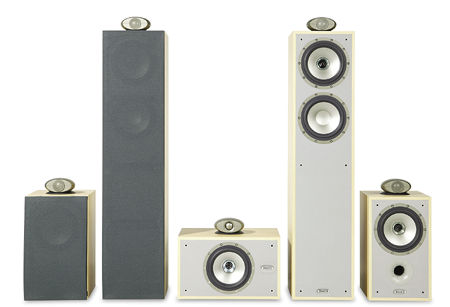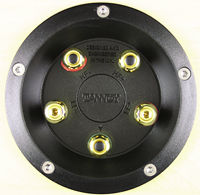Tannoy Sensys Loudspeaker System
Take a close look at the new Tannoy Sensys DC speakers. Notice anything unusual? Anything at all? I suppose that little gray pod sitting atop each speaker will catch your eye first. It's home to a SuperTweeter that's designed to extend the speaker's response out to a range that only dogs and bats can hear, claimed to be all the way up to 51 kilohertz. Look again and scrutinize the 7-inch woofer with bull's eye circles in its center; that's another, albeit standard, tweeter. Tannoy dubbed their "tweeter inside a woofer" design as Dual Concentric, a hallmark of the company's upper-end speakers that dates back to (gulp) 1948. Dual Concentric is a really big deal because it generates minimal off-axis phase shifts over its nearly full-range frequency response: High and low frequencies originate from the same point. The Dual Concentric breakthrough led to a range of legendary speakers in the pro audio and high-end markets for more than half a century.

The Sensys DC line benefits from kinship with Tannoy's $20,000 Churchill Wideband va-va-voom flagship, but the Sensys models are among the least expensive speakers ever offered with Dual Concentric drivers. Their sound is detailed, dynamic, and tonally linear; imaging is unerringly precise and focused. I listened with my mouth agape to a spectacular Glen Velez CD, Assyrian Rose, an all-acoustic recording of Middle Eastern percussion and flutes. The tactile sounds of hands beating taut drum heads caught me by surprise; it was viscerally organic and whole. The Dual Concentric's advantages are very real; I've never heard a speaker anywhere near this price that could match this sound. And this was in stereo, relying on just the floorstanding Sensys DC2 ($1,300/pair). This handsome tower stands a shade over 38 inches tall and weighs 37.5 pounds, but it feels heavier. The DC2's front baffle is covered with dark gray fabric, which adds a certain refinement to the Sensys' look. The driver complement includes that pod-mounted, 1-inch titanium dome SuperTweeter, set back on the cabinet to time-align it with the acoustic center of the Dual Concentric's 7-inch midwoofer and 1-inch titanium dome. You can't actually see that dome, as it resides behind a wave guide that is said to produce a spherical wave launch to better blend with the midwoofer. The second, 7-inch driver is a paper woofer. Yeah, I know the woofers look metallic, but they are, in fact, "multi-fibre paper pulp." Old-fashioned, yes, but I know lots of speaker designers who believe that nothing sounds better than paper woofers.
 The squat, 13.75-inch-wide DCC center speaker ($549) forgoes the standard woofer-tweeter-woofer arrangement in favor of a single Dual Concentric 7-inch unit and the topside SuperTweeter. You can use the 16-inch-tall bookshelf model, the DC1 ($500), as a surround or front speaker. It features the same driver complement as the DCC. In back, all three models feature impressively solid all-metal, biwireable binding posts that are more than a few notches above the sort I usually spot on affordable speakers. Beyond the four de rigueur biwire posts, a fifth post offers a separate ground link to the amplifier. Tannoy claims that you can use it to reduce the radio-frequency noise and hash that the speaker's voice coils pick up. Whatever. Two sets of grilles come with each speaker: a conventional full-height, cloth grille and a nifty little circular mesh screen to protect the SuperTweeter. The Sensys speakers are all magnetically shielded; finishes are limited to maple, black ash, and a rosewood vinyl wrap. Considering the Sensys' stellar build and sound quality, Tannoy's pricing is flat-out remarkable.
The squat, 13.75-inch-wide DCC center speaker ($549) forgoes the standard woofer-tweeter-woofer arrangement in favor of a single Dual Concentric 7-inch unit and the topside SuperTweeter. You can use the 16-inch-tall bookshelf model, the DC1 ($500), as a surround or front speaker. It features the same driver complement as the DCC. In back, all three models feature impressively solid all-metal, biwireable binding posts that are more than a few notches above the sort I usually spot on affordable speakers. Beyond the four de rigueur biwire posts, a fifth post offers a separate ground link to the amplifier. Tannoy claims that you can use it to reduce the radio-frequency noise and hash that the speaker's voice coils pick up. Whatever. Two sets of grilles come with each speaker: a conventional full-height, cloth grille and a nifty little circular mesh screen to protect the SuperTweeter. The Sensys speakers are all magnetically shielded; finishes are limited to maple, black ash, and a rosewood vinyl wrap. Considering the Sensys' stellar build and sound quality, Tannoy's pricing is flat-out remarkable.
The speakers are all ported. As with any speaker, placing them near walls might induce an overabundance of bass. You got a problem with that? The nice folks at Tannoy included, ahem, "damper bungs"—aka foam plugs to stop-up the ports and attenuate a bit of the low-end oomph. Then again, some folks crave big bottom ends, and unbunged DC2s may strike their fancy.
I fed the Sensys speakers with my Sunfire Theater Grand III pre/pro and Ayre V-6x power amp. To bring things down to a real-world level, I also substituted a $599 Marantz SR5400 receiver for the pre/pro and power amp. I divided my audition time equally between the two sets of electronics and, sure, the pricier components added a greater sense of gravitas and refinement to the sound. My Denon DVD-2900 universal player delivered the goods to both sets of electronics. I found the Sensys speakers to be somewhat directional; they sound best when you aim them just behind the sweet spot. Tannoy's next-generation TS Series subwoofers were still a few months away when I worked on this review, so I pressed my trusty REL Storm III subwoofer into service. Tannoy's subs should be at their dealers by the time you read this.
The Sensys' uber-resolution paid big dividends as I indulged in many an SACD and DVD-Audio listening marathon. Oh man, the Chicago V DVD-Audio disc conjured a remarkably coherent soundstage, more like super-stereo than a discontinuous hodgepodge of instruments popping out of the mix. The entire disc sounds great, but the bonus track, "Dialogue" (recorded live at Chicago's Aerie Crown Theatre in 1972), became my go-to demo. The Sensys' vivid 3-D portrayal of the band and crowd was as good as it gets.
Dylan's Blonde on Blonde SACD displayed a newfound believability and scale, so the music was more vital than ever. I could hear "into" Dylan's recordings. I was more aware of his sound filling the studio, and I felt like I was witnessing the man making his music. This isn't any sort of effect or trick that the Sensys speakers generated. The sound of the Rolling Stones' one and only 5.1 offering, the Sympathy for the Devil remix, sounded totally synthesized. Bass definition was nice and tight, but the low low-end was a tad lazy and slow. The percussion and "whoo-whoo" chorus coming from the surround speakers sounded disembodied, unrelated to the music that was rocking out of the front three speakers. Hey, it's not a great mix, and the Tannoys just tell it like it is.
Since the Super(duper)Tweeter doesn't make its entrance until 16 kHz, I was more than a little curious about the audibility of its very high-frequency output. I conducted a simple experiment: I blocked the tweeters with some socks. Yes, even my 54-year-old ears could detect a significant loss of spaciousness in the music. On Chesky's Swing Live DVD-Audio disc, the vibraphone lost its transient sheen, and cymbals didn't sparkle when the socks were soaking up the tweeters' contributions. SuperTweeter skeptics might want to duplicate my sock test or request a copy of Tannoy's White Paper on the SuperTweeters.
What about home theater sound? The Matrix Reloaded DVD displayed the sort of extra texture that I associate with electrostatic speakers, but those panel speakers never achieve the sort of razor-sharp imaging that you get from the Sensys speakers. Reloaded's pumped-up special effects stressed the Sensys ensemble at silly loud levels; when I backed the volume down a few decibels, the sound smoothed out. Morpheus' testicularly endowed voice got down to Darth Vader's menacingly low range through the DCC center speaker. Dialogue not only comes across fully formed and solidly present, but you hear inhales and exhales, subtle inflections and hesitations that lesser speakers miss. The body thuds in the kinetic fight scenes sounded more realistic, and I also noticed a heightened sense of ambience and low-level detail in the quieter scenes. Most speakers gloss over stuff that the Sensys speakers divulge.
Reloaded was fun, but Tears of the Sun provided more-realistic sound. Much of the action takes place deep in the African jungle, and the canopy of sounds—insects, birds, rain, and distant thunder—were all palpably present. This emotionally wrenching film about ethnic cleansing and tribal warfare has its share of violent, slam-you-back-in-your-chair sounds, and the Tannoys never faltered. My engagement in the story was total, and isn't that what this is all about?
Feed these Sensys speakers a well-recorded DVD or CD, and you'll be treated to ravishing depth and a wide-open spaciousness, although I sometimes thought I heard a very slight cupped-hands honk in the upper midrange. Remember, the tweeter is, in effect, horn-loaded by the 7-inch woofer, so that might be the source of the horn "coloration."
In day-to-day use, the Tannoys' extraordinary detail comes at the cost of highlighting the weaknesses of less-pristine recordings. The Ani DiFranco track on the first Sessions at West 54th DVD sounded a touch sibilant and grainy, but Lyle Lovett's "Step Inside This House" on Sessions, Volume 2 was sweet as could be. Like I said, the Sensys are very revealing speakers. In case you haven't noticed, I'm totally jazzed by their sound. You've gotta hear Tannoy's amazing Sensys speakers for yourself.

Highlights
• The SuperTweeter is SACD- and DVD-Audio-ready
• High-resolution sound has never been this affordable
• Sharp Euro styling
Sensys DC2 Floorstanding Speaker $1,300/pair
Sensys DCC Center-Channel Speaker $549
Sensys DC1 Bookshelf Speaker $500




























































